
HOW TO REMOVE THE RUST FROM THE MACHINE
Content
- Causes of rust
- Types of rust
- Where does rust appear most often?
- How to remove rust from a car
- Rust remover
- Rust converter
- How to remove small rust stains: tools and procedure
- Prevention
- Fiberglass Rust Repair
- Why storing a car in a garage does not always save you from rust
- Galvanized body
- Other tips for removing rust from the body
- Related videos
- Common questions:
The modern driver wants to maintain the maximum presentability of the car, no matter what. But over time, certain dents and scratches, as well as chips, inevitably appear on the body. Such flaws spoil the car's exterior. They become the foundation for the formation of corrosion resistant. This review tellshow to remove rust on the VAZ-21099 door pillar, or rather, how to unscrew the front door if there are no suitable tools at hand.
Causes of rust
A key cause of rust is contact of moisture and air with exposed metal. Although every car undergoes a thorough anti-corrosion treatment at the stage of assembly, over time, rust can appear on any car. There are several factors that affect this.
Long service life of the vehicle
Even the thickest paintwork gets thinner over time. Even a simple brushing off of dust from the car body with a dry cloth will imperceptibly destroy the varnish. This layer is not visible, so the problem is difficult to notice right away.

The thinner the layer of varnish (or none at all), the faster the base coat will deteriorate. Moreover, not all cars are covered with high-quality varnish, so the car is practically devoid of effective protection, and very quickly begins to deteriorate.
Negligent attitude to the car
Scratches, chips, scuffs and other damage to the paintwork appear as a result of careless handling of your vehicle. If a motorist parks by sound, is inattentive while driving, often drives near bushes or branchy trees (typical for off-road enthusiasts), then the paintwork will quickly get damaged.
Often, such motorists do not attach importance to insignificant "mushrooms", but try to do something when the rust has already eaten a huge hole. In such advanced cases, you only have to cook the body, and then process it.
Influence of climatic conditions
Sometimes some factors are beyond the control of the motorist. Severe hail, frequent changes in temperature and humidity, chemicals that sprinkle on winter roads - all this aggressively affects the condition of the paintwork on the car.
Types of rust
In addition to the negative impact on the presentability of the car, rust can cause damage to an important unit. And some malfunctions can create an emergency on the road. For example, many suspension or chassis parts are susceptible to aggressive moisture.
If the owner of the car does not periodically check these systems, then at the most inopportune moment at high speed, he may encounter a sad "surprise".
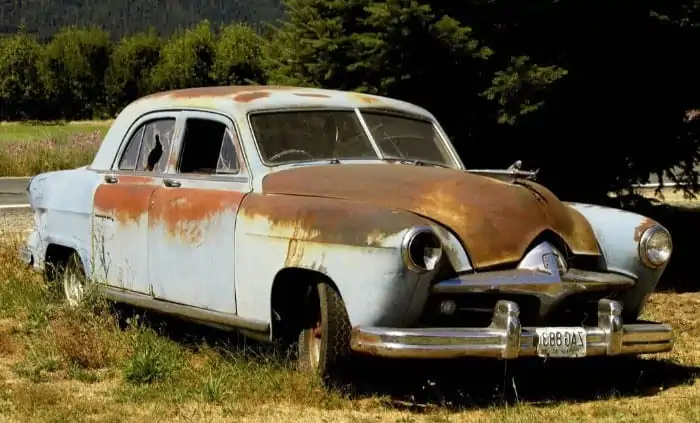
Of course, not every type of rust is so dangerous. If we conditionally divide the manifestation of the oxidative reaction of the metal, then three types are distinguished.
1. Cosmetic corrosion
Surface oxidation, which most often looks like plaque on the surface of a metal part or a slight change in color. Appears in places that are poorly treated with an anti-corrosion agent. On the body, this type of corrosion appears as a result of violation of the paint coating layer (how to fix different types of scratches can be read here).
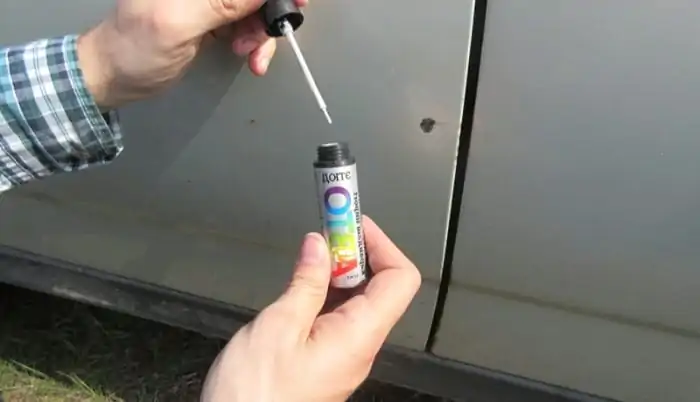
At the stage of manufacturing body parts, they are lowered into a container with hot zinc. When the solution cools, a layer forms on the metal that protects against oxidation of the metal. Then the surface is treated with a paint and varnish coating, which gives the car a stylish look and serves as additional protection for the metal.
During the operation of the machine, the paintwork is faced with the aggressive effects of a sharp change in temperature. For example, in the spring morning the temperature drops below zero, and in the afternoon the sun can greatly heat the metal. The ultraviolet radiation of the sun, moisture, mechanical stress (vibration, shock and scratches) - all this contributes to the destruction of the protective layer of the body.
2. Penetrating corrosion
Often these types of damage are called end-to-end. They are formed in places where it is difficult to notice the initial stages of metal destruction, for example, the inside of doors, the trunk lid, hood, the back of the wings, the bottom, etc.
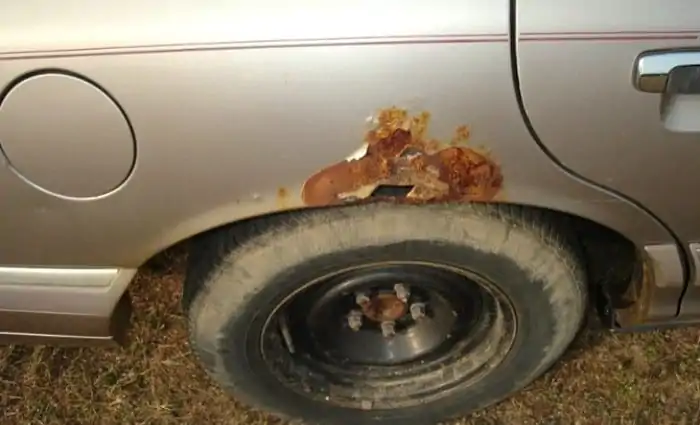
Most often, corrosion begins to develop in places where moisture and dirt accumulate. Since these are hard-to-reach places, it is difficult for the driver to notice the problem on time. When rust appears on the surface, no measures to eliminate corrosion will help - the metal has rotted. In this case, the part must be changed to a new one or complex reconstruction work should be carried out.
3. Structural corrosion
Unlike the first two types of metal damage, this variety is the most dangerous. It manifests itself on the load-bearing power elements of the car. The most common place where it forms is the bottom. If timely anti-corrosion treatment of such elements is not carried out, the stiffness coefficient of the car body is reduced, which negatively affects the safety of travel.
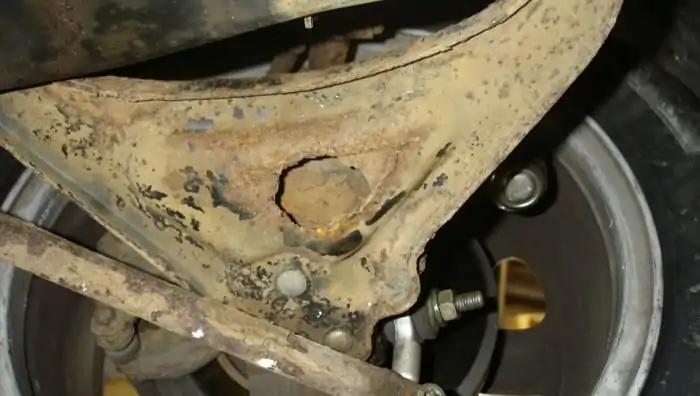
Since the supporting elements of the body must retain their strength even when rust appears, they are made of thick metal. Thanks to this, most cars that have lost their presentable appearance due to the characteristic red-brown plaque retain their performance characteristics. This makes it possible to carry out work to remove traces of corrosion instead of the need to purchase a new car.
Where does rust appear most often?
Given the causes of corrosion listed at the beginning of the review, the most problematic areas are:
- Thresholds - they suffer not only from exposure to moisture, but also from mechanical stresses (in winter many people hit them with the soles of their boots to brush off the snow). As a result, the paintwork is deformed, scratches and chips appear on it.
- Wheel arches are a “favorite” place of through corrosion, since the metal in these areas is thin and the protective layer is scratched by small stones on the side of the wheels. In most cases, plastic protection is attached to the arches using self-tapping screws. The constant contact of moisture and dirt destroys exposed metal areas.
- The hood is exposed to heat from the engine, as well as small deformations when moving and opening / closing.
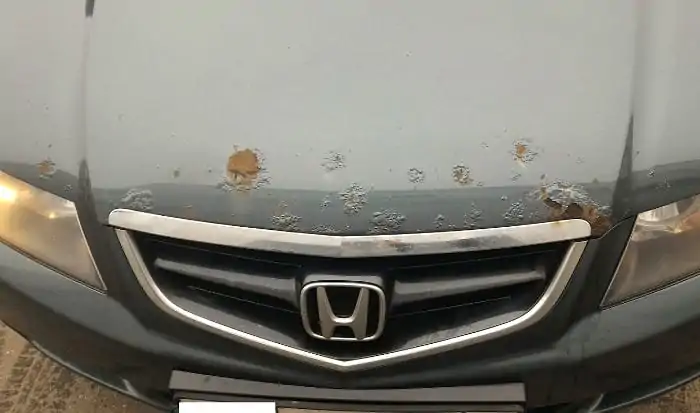
- The doors in many car models begin to rot in the lower part - in the area of the drainage holes. These body elements are often subject to through corrosion, since the paintwork on them provides protection only from above. Cosmetic corrosion appears due to scratches and bumps in the side of the car.
- After welding repair work, a poorly processed seam will certainly oxidize the fastest. To prevent oxidation, it must be treated with an anti-corrosion agent and coated with a protective layer (for example, bitumen mastic, if this is the bottom).
When the first signs of oxidation of certain parts of the body appear, care should be taken to eliminate them as soon as possible.
How to remove rust from a car
In a separate review the example of VAZ 21099 shows how this process takes place. The very first thing to do is to determine what type of defeat. Corrosion manifests itself in different ways. Therefore, in each case, an individual selection of a method for eliminating the defect is needed. The most common body damage is:
- minor spots formed on the surface - they are removed by conventional cleaning, as well as subsequent processing with a primer;
- multiple flaws - if rust is not timely removed, the body will begin to rot;
- through damage - a defect in the form of through holes is difficult to eliminate, you will have to use patches.
Plaque or stains must not be ignored. Otherwise, there will be a need to invest a lot of finance in car repair. 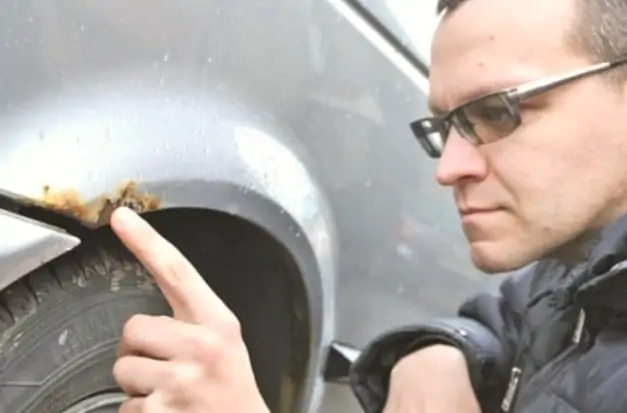
Mechanical rust removal
To eliminate the effects of oxidation, a grinding tool is required. This can be a grinding machine with emery nozzles of different grain sizes, a brush for metal, sandpaper. The most effective tool is the one that removes the smallest residues of rust. A wire brush is only effective in removing large particles of the affected metal that breaks off.
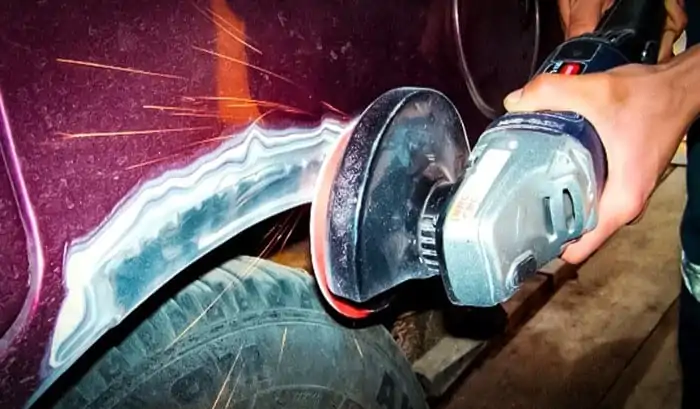
The essence of the procedure is to remove all rust from the surface of the part, stripping the area to clean metal. First, large particles are removed, then, decreasing the grit size of the sandpaper, the areas that are particularly affected by corrosion are spotted.
A more expensive but more efficient method is rust removal using a sandblasting machine. It provides accurate cleaning without damaging a suitable metal layer.
Chemical rust removal
If it is not possible to use a sandblasting machine, and rust damaged the metal unevenly (depressions of different sizes are observed), then in order not to remove a good layer of metal, chemical means should be used.
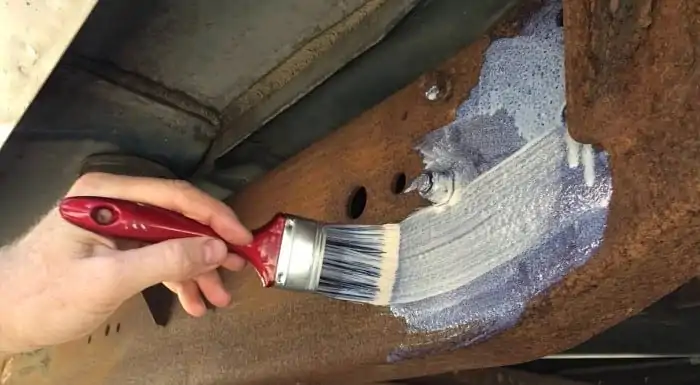
They include reagents that react with the oxidized metal without affecting the good layer. The advantages of such processing:
- microscopic removal of rust;
- ease of use (it is enough to apply the solution to the surface in accordance with the manufacturer's instructions);
- high rust removal rate;
- a large selection of substances;
- additional protection of metal after coloring.
Many products can be used without prior machining. When using them, it is extremely important to follow safety precautions: eyes, respiratory tract and skin must be protected from exposure to caustic substances. They do not always hit as fast as punctures, bumps or cuts. Sometimes the effect of acids appears on the skin after some time (depends on the aggressiveness of the environment). In any case, you need to protect yourself so that after repairing the car you do not have to be treated.
Super way for hi-tech lovers
Such an unusual method of combating corrosion on the body of a car soars in the vastness of YouTube. As shown in such videos, to complete this procedure you will need:
- Zinc tip electrode;
- Battery wires;
- Rust converter.
Instead of this set, you can use the tools at hand:
- AA batteries with zinc case;
- Wires;
- Cotton tampons;
- Phosphoric acid (as a rust converter);
- Baking soda;
- Insulating tape;
- Latex gloves.
A zinc-cased battery replaces the zinc electrode. It is connected to the battery and after processing the rusty place with acid, it is applied to the metal. According to the creators of these rollers, in addition to removing rust, a zinc layer is applied to the cleaned surface, as in the case of galvanizing the body.
Rust remover
Anti-corrosion agents are often used based on formalin. In addition, sulfuric acid, caustic soda and ammonium, oxalic, nitric and hydrochloric acids, as well as kerosene are used. But this approach does not guarantee a one hundred percent effect. Some products are hazardous to health. Therefore, the chemical processing method is considered the most reliable.
The car market offers a wide variety of products that can resist corrosion. At least rust converter along with modifiers is recognized as the best. They are made from polymers. Such products contain a primer. They convert iron oxide into a layer of chromates and phosphates. It removes rust and penetrates into hard to reach places. This tool is used even for preventive purposes.
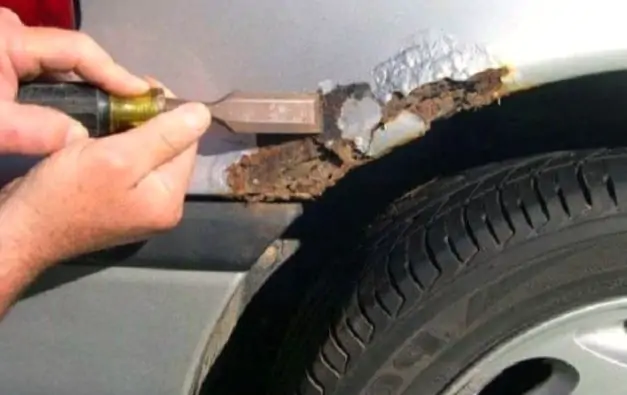
Rust converter
This tool perfectly copes with the task of removing oxidized metal particles that have not been removed mechanically. The use of a rust converter allows you to preserve the workpiece as much as possible, which cannot be done when processing with a grinder, but at the same time it copes with rust more effectively than a metal brush.
The product works at a chemical level. It converts the layer of rust into a mass that is easy to clean. In some cases, after applying the converter, the car body does not need to be subjected to additional processing, but a primer is immediately applied. This procedure can be performed if the layer of rust-affected metal is not deeper than 100 microns (1000 micrometers in one millimeter). It turns out that the use of the transducer is possible if the lesion does not exfoliate.
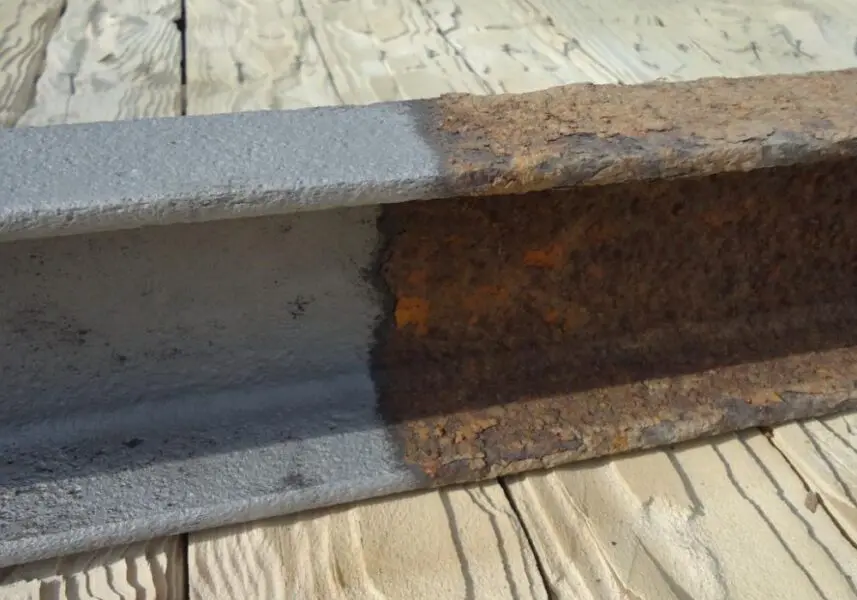
All rust converters can be classified according to the following criteria:
- The composition is acidic, neutral, or one that, when processed, creates an additional protective film. Such products can be sold already diluted or in several components in a set that must be mixed before surface treatment;
- Action - after transformation, the mass must be removed from the surface or it can be used as a primer;
- The consistency is liquid, gel or paste.
Before using the converter, it is very important to familiarize yourself with the composition of the product. If an acid is used in the base, then it should be noted that each type of acid has its own effect on corrosion, therefore, the surface treatment after using the product will be different. For example, orthophosphoric acid localizes corrosion and promotes adhesion of paintwork, and an inhibitor simply slows down the process of rust formation, but does not eliminate the corrosion itself.
You do not need to have special skills or knowledge of chemistry to use the transducer. To do this, it is enough to carefully read the instructions for use, and strictly follow the manufacturer's instructions.
The agent will achieve the maximum effect if, before use, the surface is still treated mechanically - using sandpaper, a metal brush or a grinder with a grinding wheel. It is also important that the metal to be treated is free from grease and not wet.
The converter itself is applied with a brush or by spraying with a spray bottle (special bottle with a hand spray). The amount of liquid applied depends on the degree of damage to the area. It must be applied until the corrosion turns into a homogeneous mass, which can then be removed.
How to remove small rust stains: tools and procedure
When cleaning mechanically, it is important to consider that in addition to rust, an abrasive tool partially removes a good layer of metal. Care must be taken so that the part does not become too thin. The procedure for the mechanical removal of corrosion:
- the tool with an abrasive wheel (grinder or drill with a grinding nozzle) removes most of the rust;
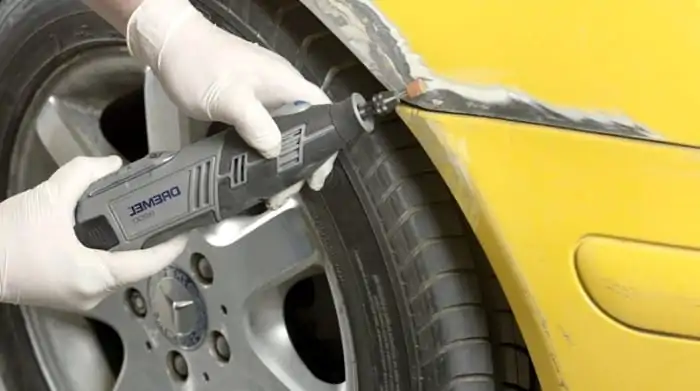
- in small areas, damage is repaired locally with sandpaper;
- to prevent the oxidation process, the cleaned surface is treated with a rust converter;
- most transducers should be dry after application (do not wipe with a cloth);
- if the damaged area is a deep and even smooth transition will be visible from the side, putty should be used;
- putty is better to be applied in several thin layers, rather than one continuous one - this is less likely to crack when dried;
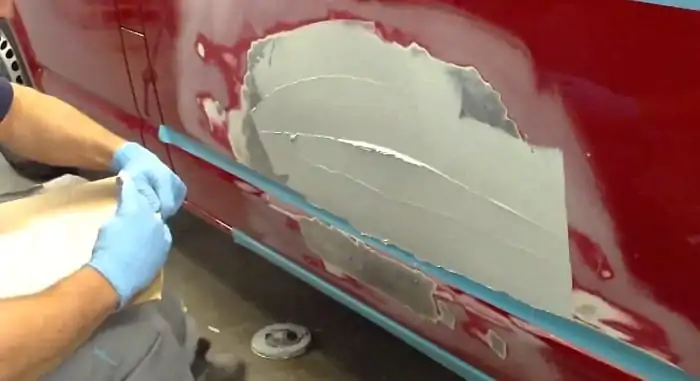
- each dried layer of putty is ground;
- areas that do not need to be processed must be covered with masking tape, film or newspapers;
- the first coat of paint and varnish is a primer (such products contain anti-corrosive substances and provide better adhesion of cosmetic layers to metal or putty);
- for light painting, a white primer is required - it will not change the shade of the paint and there will be no stains on the machine;
- the primer is applied in several thin layers with each drying for about 25 minutes. (the exact parameter is indicated on the container of the product);
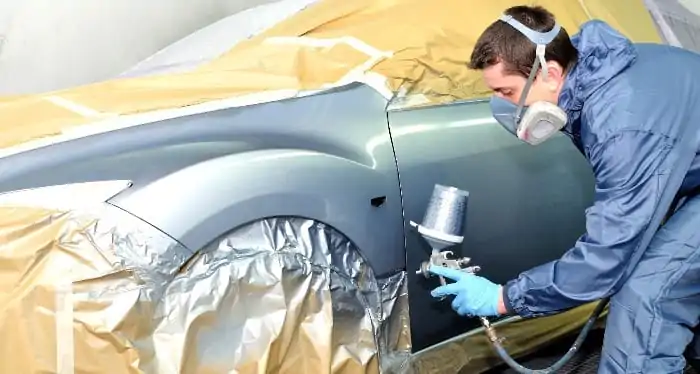
- painting and subsequent application of the varnish coating is carried out in the same way as the primer of the body - two or three layers with drying of each of them;
- after the paint has completely dried (after a couple of days), the car is polished to ensure uniform gloss.
If you decide to use a chemical rust remover (it is often used to form cosmetic rust), you must remove paint around the area to be treated before applying it. After the applied substance has dried, the area must be treated with sandpaper to make it smooth. Further, the procedure is identical to that described above: primer, staining, varnishing, polishing.
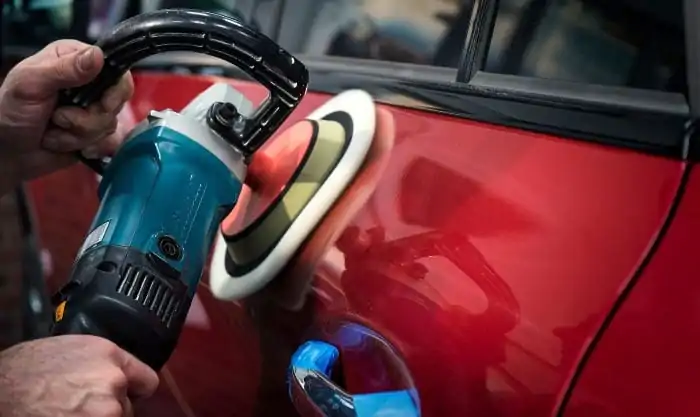
Among the effective substances for chemical rust removal, the following can be distinguished:
- Anti-rust. Sold as a concentrate, which is diluted in water in accordance with the manufacturer's recommendations. This substance also effectively removes traces of scale in radiator systems (before using it in a cooling system, it should be clarified how the reagent can affect cooling radiator).
- Fosfamit. Effective for processing cast iron and steel products. In addition to removing deep-caked rust, it creates a protective film that prevents the occurrence of an oxidative reaction. The tool is compatible with most types of paintwork.
- Ortameth. The peculiarity of this substance is the ability to use it at low temperatures (up to 15 degrees below zero). Depending on the ambient temperature, the solution dries from three to 30 minutes.
- Neomid 570. This concentrate also contains acid. It must be diluted with water in a ratio of 1: 2. If the applied solution has not removed all the rust, a second coat should be applied (if necessary, a third, etc.).
- Deoxyl-1. A popular tool that has proven effective not only for rust removal, but also for descaling and mineral deposits.
Prevention
Modern cars need regular corrosion protection. This is not an easy process, but it will help to minimize the likelihood of rust formation on the body. First of all, car care is important in winter. In the cold season, it is recommended to wash the machine several times a week using warm, but not hot water. After washing, proper drying is essential. At the initial stages, it is much easier to get rid of any damage and plaque of rust. Therefore, regular inspection of the bodywork of vehicles cannot be ignored.
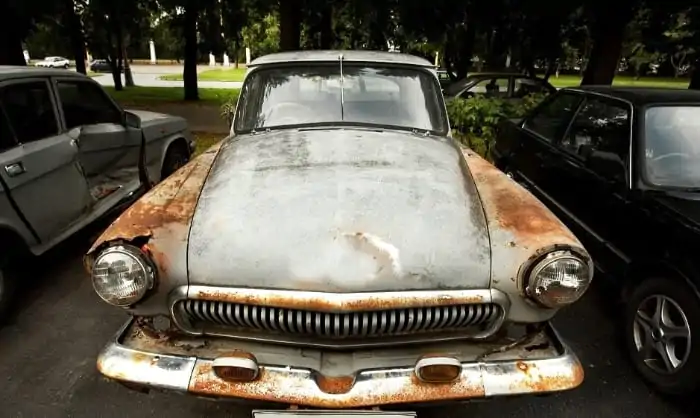
Corrosion-resistant coating must be applied to arches, the bottom and other open elements before the cold season. Sealing metal allows special processing. It will not allow the spread of rust. Paintwork requires waxing. Such protection is not durable for the body, but its effectiveness is high. After all, wax is able to stop the corresponding micropores. To create additional coverage, you need polishing.
In preparing the car for winter, you need to consider a number of tricks. Therefore, it is advisable for professionals to entrust such a process. They will help to clean the vehicle of rust deposits and create reliable protection for the car.
Fiberglass Rust Repair
The peculiarity of this material is that it is used for the manufacture of entire car bodies. It can also be used to create individual body elements. If the body part that can be replaced is severely damaged by perforating corrosion, then it can either be replaced or patched up with fiberglass.
The repair procedure is the same as when using mesh and putty. First, all rust and metal parts, even slightly damaged by it, are removed. Then the resulting hole is sealed, and several layers of liquid glass fiber are applied. In essence, a separate missing piece of the part is created. After repair, the product is sanded, primed and painted.
Why storing a car in a garage does not always save you from rust
For many motorists, storing a car in a garage is a panacea for rust formation. In many cases, garage storage is really an indicator of gentle vehicle care. But it's not always the case. Sometimes it's better to keep your car outdoors instead of in the garage. The reason is what kind of garage it is.
The car will stay well in a properly ventilated garage, as well as where it is dry. You should also pay attention to the floor in the room. If it is just earthen, then in almost one season, mushrooms and fistulas will appear on the bottom. For this reason, creating a shelter for storing vehicles, you need to provide proper ventilation, make a concrete floor (some motorists use a budget option - a solid piece of thick linoleum, but this is only temporary protection), and, if possible, protect it from moisture.
Galvanized body
This procedure belongs to the category of passive protection of the body against rust formation. It's simple enough to be done on your own. In the stores that sell car chemicals, you can buy any tool that allows you to get the job done. One of the options is Tsinkor-Auto.
This product is intended for the treatment of a small surface area that already shows signs of corrosion. Its peculiarity is that it has a galvanic effect. That is, the agent forms a film of zinc molecules that covers the affected area of the metal.
The Zinkor-Auto set consists of two bottles with liquids of different composition (one contains a rust converter, and the other contains a solution with zinc), working electrodes and connecting wires.
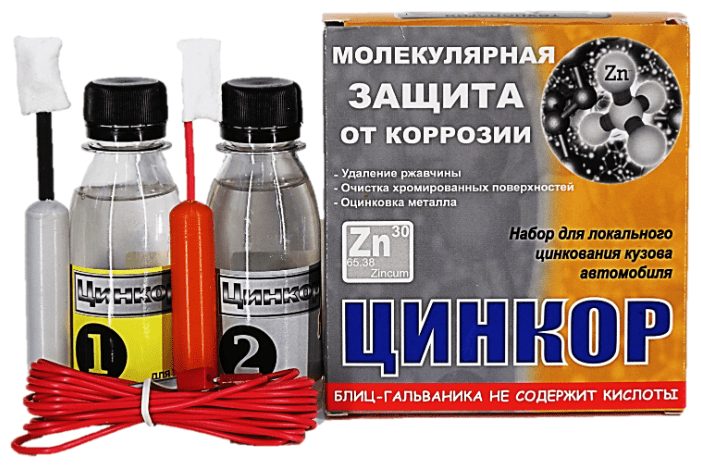
Here's a quick guide on how to use this tool:
- Rust is removed from the damaged area. Even if the paint is swollen, it must be removed to prevent the damage from spreading further.
- The car is put on the handbrake and the engine starts.
- One wire sits on the positive terminal of the battery. The other end of this wire connects to a red electrode. In doing so, it is important to make sure that the negative terminal has good contact with the car body. Otherwise, the galvanic effect will be weak.
- There is a sponge on the red electrode. It is dipped in a bottle of rust converter and the area affected by the rust is carefully treated until the metal is completely free of corrosion.
- The wire is disconnected, the area treated by the converter is thoroughly washed out with water.
- Further, a gray electrode is connected to the wire instead of a red one.
- The metal section is processed in an identical way, only this time using a zinc solution. The procedure continues until a sufficient zinc film forms on the surface.
This procedure is distinguished by its effectiveness, since after processing the damaged area retains its visa for several years. Therefore, many craftsmen recommend using such products when chipping and other damage that reach the metal and cause corrosion.
Other tips for removing rust from the body
Here are some tips that experts recommend for doing work at home:
- The solution consists of a glass of water (250 ml.), 53.5 g of ammonium, 52 g of caustic soda, 200 g of formalin. Another 250ml is added to this mixture. water. The part is immersed in this solution for half an hour. Traces of rust are removed, after which the part is dried with a hair dryer.
- To the same solution, add 1 liter of a 10% solution of sulfuric acid or a similar volume of hydrochloric acid (10% solution). The metal is cleaned of traces of corrosion and dried with a hairdryer.
- The damaged surface is treated with fish oil. This method is suitable for shallow damage. The substance is applied to the surface and left for a couple of hours. After the time has elapsed, wipe it off with a dry cloth. A thin film forms on the treated surface, preventing direct contact of moisture with metal.
- Fine rust (pinpoint) is removed with a cloth soaked in kerosene.
- Another good way is to apply a paste of oil mixed with charcoal to a rust-free surface.
Related videos
Here are a couple of videos on how to easily remove the effects of rust on the car body:


Watch this video on YouTube
Common questions:
How to cover up rust on a car? To do this, use any formalin-based rust converter. By treating the corroded area with a converter, you stop the spread of rust.
How to clean rust from a car body? Proven means "Tsinkar" in the form of a spray. The composition is applied to the area damaged by corrosion, after a few minutes there will be a clean area at the treated area, requiring instant primer treatment.
How to stop rust on a car? To do this, you need to completely get rid of foci of corrosion, then clean all drain holes and perform high-quality anti-corrosion treatment.
